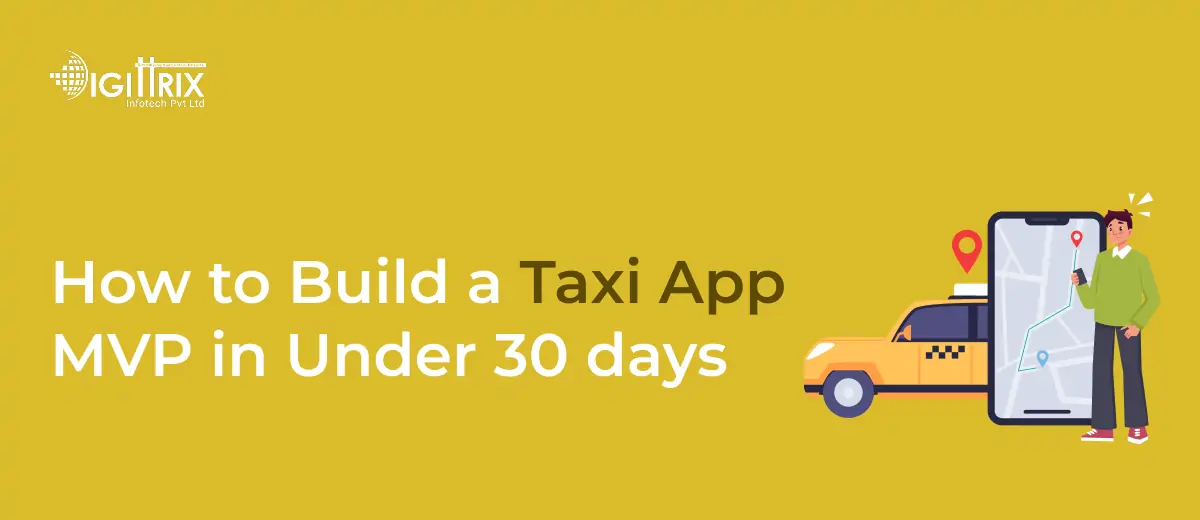Build a fully functional taxi app MVP in under 30 days with essential features, market testing, and fast launch strategies for quick user help and feedback.
Highlights
An enthusiastic developer and skilled business management expert with over a decade of experience in the field

Launching a taxi service through a mobile app has become one of the fastest-growing business opportunities worldwide. However, developing a fully equipped platform from scratch often requires significant investment and lengthy development times. That’s why many businesses start with a Minimum Viable Product (MVP), a simpler version of the app with essential features, allowing you to test the concept, attract early users and gather feedback.
This guide shows how to build a taxi app MVP in under 30 days with a simple, step-by-step process that anyone can follow. Whether you’re working with a taxi app development firm, hiring an independent Android developer, or partnering with an iOS developer, this approach helps you go from idea to launch quickly.
Planning to build a bike taxi app? Learn the cost breakdown and key factors for developing a successful bike taxi app in 2025.
An MVP isn’t a basic product with no value; it’s the essential version of your app, concentrating on key functions. For a taxi booking app, the goal is to enable passengers to book rides, drivers to accept trips, and both to communicate easily.
Starting with an MVP lets you test your on-demand taxi booking app in the market without wasting months on features users might not need early on.
The planning stage is important if you aim to launch within 30 days. This is where you outline:
You should also decide early whether you’re focusing on developing a taxi booking app for private rides or if you will add extra features like a carpooling app for shared trips.
Building an MVP in under 30 days requires dividing the work into weekly targets:
If you’re working with a taxi app development company, ask for a sprint-based approach to allow weekly progress tracking. When collaborating with freelancers, make sure both your Android and iOS app developers follow the same schedule.
The design phase is where your app starts to take its visual shape. Good design should make sure the app is easy to navigate and a pleasure to use. Focus on:
During this phase, you can also prepare the design for your on-demand taxi booking app driver panel, which will allow drivers to accept or reject trips.
The backend is the core engine that manages bookings, connects passengers with drivers, calculates fares, and stores ride information. Common choices for backend development include Node.js, Python, and PHP.
If you intend to support both private taxis and shared trips, you may need extra modules to build a carpooling app that groups passengers heading in the same direction.
For the passenger side of the taxi app development process, focus on essential screens:
Even if your long-term plan includes advanced features, your MVP should adhere to this basic list to hit the 30-day target.
The driver app also needs essential functionality:
A skilled Android and iOS app developer can quickly build both versions if the backend is properly prepared.
Some features require integration with third-party services:
Partnering with a taxi app development company can accelerate this process since they often possess ready-made modules for common features.
Testing is where you find and fix problems before launch. This step should include:
If your mobile app development team is sizeable, divide testing responsibilities between developers and dedicated testers.
Once the app is tested, it’s time to get ready for launch. This includes:
If the review process runs smoothly, your on-demand taxi booking app can be ready for users in less than 30 days from the start of development.
After launch, the most important step is to gather user feedback. Early users will identify missing features, design flaws, or suggest improvements. Since the MVP is just the initial version, you can make adjustments gradually based on real-world use.
Once your MVP is live and tested, you can start adding more features such as:
Your mobile app development journey doesn’t end at launch; it evolves with your market’s needs.
Developing an MVP in less than 30 days typically costs less than building a fully-featured app. Factors affecting the price include:
Even though the cost is lower, remember that quality counts. The app must be reliable and simple to use.
Launching quickly gives you several advantages:
This approach is particularly beneficial for startups entering competitive sectors such as taxi booking app development.
Planning to develop a taxi app? Explore the ideal technologies for building a scalable and efficient taxi booking platform.
Building a taxi app MVP in less than 30 days is completely achievable with proper planning, a skilled team, and a focus on key features. Whether you decide to work with an experienced taxi app development company or hire your own Android and iOS app developers, keeping the project scope limited will help you meet your launch deadline.
By concentrating on the fundamentals first, booking rides, connecting drivers and passengers, and enabling secure payments, you can quickly test your on-demand taxi booking app in the market. From there, features like carpooling app development and other advanced options can be added based on genuine customer feedback.
Your initial draft doesn’t have to be perfect; it just needs to be practical, workable, and ready to meet your launch deadline.
In today’s fast-paced world, the demand for quick, convenient, and accessible transport options keeps increasing. With more Australians using taxi booking apps, both new startups and well-known companies are vying to capture market share. To stand out, it’s vital to launch a taxi app MVP that features the core functions users need, while also giving you a chance to test your idea and gather feedback for future improvements.
At Digittrix, we provide expert mobile app development services for startups entering the taxi industry. With over 14 years of experience, we assist you in developing a functional and user-friendly MVP using technologies like React, Flutter, and blockchain. Our solutions include real-time GPS tracking, ride booking management, secure payment processing, and in-app chat, helping you test your idea in the market quickly.
If you’re ready to develop your taxi app MVP and present it to potential investors, connect with our experienced technical managers. Call us at +91 8727000867 or email digittrix@gmail.com to discuss your project and start your journey towards building a successful taxi booking platform.

Do you need help in Mobile App development?




Join over 1500+ businesses we've already helped!
Beauty App Development: Tips to Grow Your Business Through an App & Cost in India (2026)
A taxi app MVP is a basic version of a taxi booking app with only essential features, designed to test the idea and collect user feedback.
Yes. With proper planning, the right development team, and a focus on essential features, an MVP can be ready within 30 days.
Core features comprise user registration, ride booking, fare estimation, real-time tracking, payment integration, and trip history.
Costs vary depending on team size, platform choice, and complexity, but an MVP is generally much cheaper than a fully featured app.

©2026Digittrix Infotech Private Limited , All rights reserved.